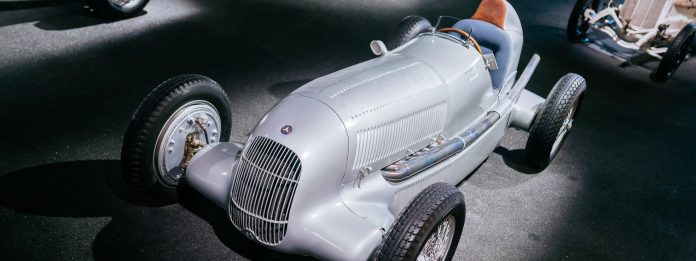- The first “Silver Arrow” can be seen at the Mercedes-Benz Museum, in the racing curve
- Manfred von Brauchitsch won the Eifel race at the Nürburgring on 3 June 1934
- The 750-kilogram formula racing car W 25 established the tradition of the Silver Arrows
“Close-up” – the name of this series from the Mercedes-Benz Museum says it all. Each instalment tells a surprising, exciting or behind-the-scenes story, illuminating details of a vehicle, an exhibit or an architectural or design feature. In the spotlight this time: the Mercedes-Benz 750-kilogram formula racing car W 25 of 1934, the first Silver Arrow.
No. 4/2024: Mercedes-Benz W 25 formula racing car of 1934
Nobility: 90 years ago, this silver single-seater coined the name that still applies to Mercedes-Benz racing cars today – “Silver Arrows”. The Mercedes-Benz W 25 made its debut in the Eifel Race at the Nürburgring on 3 June 1934. Manfred von Brauchitsch won the race, setting a new track record with an average speed of 122.5 km/h. This was the beginning of a success story that extends to the latest racing cars of the Mercedes-AMG Petronas Formula One team.
Racing curve: The Mercedes-Benz Museum celebrates the brand’s unique tradition of sporting success in Legend Room 7 with its spectacular racing curve. The W 25 can be seen here as a star amongst many other bright silver racing cars from the brand. The room is called “Silver Arrows – Races and Records”. An apt tribute to the Grand Prix racing car. This is because record-breaking vehicles with eight- and twelve-cylinder engines were also derived from the first Silver Arrow.
Reduced: How did the drivers feel in the 750-kilogram formula racing car W 25? The view from the cockpit over the large, slim steering wheel and through the small windscreen into the racing curve with the other Silver Arrows gives an impression. The dashboard with a rev counter plus oil and coolant gauges is reduced to the essentials.
Streamlined: The W 25 is an aerodynamically optimised monoposto with exposed wheels. It stands for a new era of racing car construction at Mercedes-Benz.
Speed: The W 25 was a fast performer, reaching top speeds of up to 300 km/h. But speed also counted in the pits. This is why the bonnet, which has many ventilation slots, has quick-release fasteners. It can therefore be opened in just a few seconds without tools.
Lightweight: Frame, gear lever, pedals and even the suspension straps of the exhaust – holes bored to save weight can be found in many areas of the W 25 at the Mercedes-Benz Museum. This shows the importance of lightweight construction during its development. The weight even determined whether the car could take part in a race: the Grand Prix racing formula announced in 1932 by the umbrella organisation Association Internationale des Automobile Clubs Reconnus (AIACR) stipulated that racing cars could weigh a maximum of 750 kilograms without operating fluids.
Anecdote: The 750-kilogram racing formula and the silver body of the Mercedes-Benz W 25 make for a fascinating story. It was told by the brand’s famous racing manager, Alfred Neubauer: apparently the W 25 painted in the traditional white racing livery weighed one kilogram too much before the Eifel race. The paint was ground off overnight. At the starting line, the “Silver Arrow” astonished the spectators with its bare aluminium skin and met the weight requirement exactly.
Development project: The W 25 was developed from 1933 as a classic front mid-engined racing car. It was further improved during its use in motorsport until 1936. It made its debut with a supercharged 3.4-litre in-line eight-cylinder engine (M 25 A), which delivered up to 260 kW (354 hp) at 5,800 rpm. The 4-litre M 25 B engine with up to 316 kW (430 hp) followed in the same year, 1934. The enormous power is evident in the exhibit at the Mercedes-Benz Museum: the exhaust pipe still has a bluish tinge from the heat of the exhaust gases. The exhaust pipe runs along the left-hand side of the vehicle from the engine compartment to the heavily tapered, streamlined rear end.
Tradition: The W 25 was followed by the Silver Arrows of the 1930s and 1950s. Mercedes-Benz returned to Formula One as an engine supplier in 1994, and the brand has its own works team again since 2010. Since 1934, the Silver Arrows have won three European Championships (Rudolf Caracciola in 1935, 1937 and 1938) and twelve drivers’ titles in the Formula One World Championship: Juan Manuel Fangio became world champion in 1954 and 1955, Mika Häkkinen in 1998 and 1999, Nico Rosberg in 2016, and Lewis Hamilton won the championship in 2008, 2014 and 2015 as well as in 2017 to 2020.

